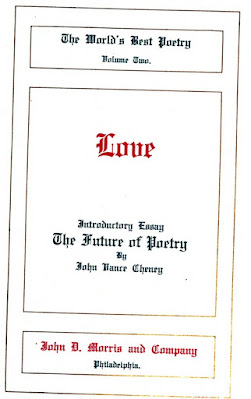The World's Best Poetry, Volume 2: Love (eBook)
by Various
THE WORLD'S BEST POETRY
I Home: Friendship
II Love
III Sorrow and Consolation
IV The Higher Life
V Nature
VI Fancy: Sentiment
VII Descriptive: Narrative
VIII National Spirit
IX Tragedy: Humor
X Poetical Quotations
Each volume has special t.p
v. 1. Of
home, of friendship; introduction: The purpose of poetry, by E. Carman;
introductory essay: Young people and the poets, by W.D.
MacClintock.--v. 2. Love; introductory essay: The future of poetry, by
J.V. Cheney.--v. 3. Sorrow and consolation; [introductory essay] An
interpretor of life, by L. Abbott.--v. 4. The higher life; [introductory
essay] Religion and poetry, by W. Gladden.--v. 5. Nature; [introductory
essay] The poetry of nature, by C.G.D. Roberts.--v. 6. Of fancy, of
sentiment; [introductory essay] The place of poetry in life, by C.F.
Richardson.--v. 7. Descriptive narrative; [introductory essay] What's
the use of poetry, by R. Le Gallienne.--v. 8. National spirit;
[introductory essay] The study of poetry, by F.H. Stoddard.--v. 9. Of
tragedy, of humor; [introductry essay] The old case of poetry in a new
court, by F.A. Gummere.--v. 10. Poetical quotations; [introductory
essay] After all, what is poetry, by J.R. Howard
The second of ten volumes of poetry edited by Canadian poet laureate Bliss Carman (1861-1929). This collection includes a range of famous and influential love poems relating to such topics as admiration; love's nature; love's beginnings; and wooing and winning. It also includes an introductory essay by American poet John Vance Cheney (1848-1922). Summary by Tomas Peter.
Buy The World's Best Poetry Books at Amazon
The PDF might take a minute to load. Or, click to download PDF.
If your Web browser is not configured to display PDF files. No worries, just click here to download the PDF file.



No comments:
Post a Comment